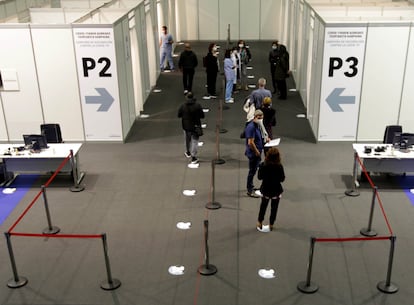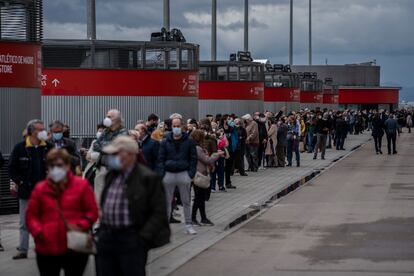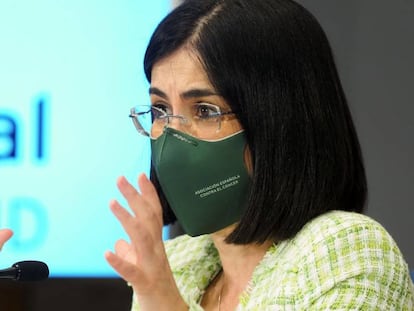Spain’s regions prepare mass vaccination sites as Covid-19 inoculation campaign gains pace
This quarter will be crucial if the country is to meet its target of immunizing 70% of its adult population by the summer. According to European Union forecasts this could happen as early as July

Last week, more Covid-19 vaccines arrived in Spain than in the entire month of January: two million doses, nearly a fifth of all of those that the country has received since the start of the immunization campaign. Should the administration rate meet the forecasts, the speed will increase non-stop over the coming weeks. In order to keep this rhythm rising, the majority of the country’s regions that haven’t done so already are opening mass-vaccination sites. The idea is to deploy all available resources in order to vaccinate 70% of the adult population by the summer and get back to normal life as fast as possible.
Madrid, for example, announced on Saturday that this week it will be using the Wizink Center arena in the heart of the Spanish capital to vaccinate members of the general population aged between 60 and 65. The region is already using the Isabel Zendal Hospital for mass vaccinations, as well as the Wanda Metropolitano stadium, which is home to the Atlético de Madrid soccer team. The latter site saw members of the public waiting in line for hours over the weekend so that they could receive a dose of the Oxford-AstraZeneca vaccine.
Other regions, such as Andalusia and Murcia, have said that they will set up more, bigger sites as the vaccines continue to arrive
In the Basque Country, meanwhile, at the weekend the authorities began to operate two mass-vaccination sites, which will join others that were set up at the start of last week as well as the bull ring in the city of San Sebastián, where teachers and police officers have been getting their shorts since the start of March. Galicia is using 14 sites, including festival grounds, spread across the region, while in the Canary Islands two major sites will be installed – one in each capital – in the second half of April. Catalonia, meanwhile, is waiting for the weekly vaccine delivery to reach 200,000 doses a week before opening six major sites. Aragón has four, which will be used once the deliveries arrive in larger quantities, while in the Valencia region the authorities will wait until they are getting 57,000 doses a day before multiplying their capacity with infrastructure such as the Ciudad de las Artes. The Balearic Islands installed what it has called “express” points on March 24.
Other regions, such as Andalusia and Murcia, which began using sports installations practically from the start of the campaign, have said that they will set up more, bigger sites as the vaccines continue to arrive. The same has been announced by health officials in Castilla-La Mancha, Navarre and Asturias.
The mass-vaccination sites are a complement to, and aimed at avoiding congestions of, health centers, which are also a key part of the immunization campaign. According to forecasts from the European Union, which is organizing the supply of the vaccines for the 27-country bloc, Spain will receive at least 30 million doses in the second quarter of the year. Combined with those that have already been administered and the doses that are yet to be injected, this will be sufficient in order to complete the inoculation of nearly 24 million people by the end of June, early July – taking into account that the 5.5 million Janssen shots included in this figure only require a single dose, and that anyone aged under 65 and who has had a positive Covid-19 diagnosis in the previous six months will only be given one injection.
The figure of 24 million people accounts for 61.3% of the adult population. This means that the objective of 70% with full protection from the available vaccines could be reached by the beginning of the summer. The first milestone on this roadmap, however, was missed: immunizing 80% of the over-80s by March. In fact, no European country managed to do this. Spain, which is on the upper part of the table in terms of percentage of population immunized and of doses administered in proportion to those received, had managed to inject 44% of this older age group by Saturday.
If Spain is to hit the target of 70% of the adult population, two things need to happen: the first is that the expected number of vaccines are actually delivered, something that did not happen in the first quarter. The second is that there is sufficient capacity to administer them. According to a number of experts consulted by EL PAÍS, this should not be a problem in Spain.
The muscle of the system is its professionals, but for it to work we need the vaccinesAmós García Rojas, president of the Spanish Association of Vacunology
While the arrival of these 30 million doses will not be uniform over the quarter, the average is 330,000 a day. Just last week more than 300,000 people were inoculated in a single day, many of them in sites away from healthcare centers – and that is even before many of the other mass-vaccination sites are put into operation across the country.
The fight against the virus is now also a fight against the clock. Each injection could become a lifesaver should the feared fourth wave take shape. The cumulative incidence of the virus began to rise on March 17, and on Saturday – a day when data is not usually released by the Spanish government – it was at 151 cases per 100,000 inhabitants over 14 days, a slight fall that was probably caused by underreporting over the Easter break.
With increased mobility over Easter – despite the ongoing restrictions in place on movement – it is likely that the incidence will continue to rise, and that is in a context where the situation in hospitals is far from good. The percentage of Covid patients occupying the country’s intensive care units (ICUs) was 19.1% according to the latest report, which is “high risk” according to the levels set out by the Health Ministry.
But this new wave will be different from the previous three that Spain has suffered since the start of the pandemic: for the first time, a significant proportion of the vulnerable population will be immunized against Covid-19. This, as Fernando Simón, the director of the Health Ministry’s Coordination Center for Health Alerts (CCAES), has pointed out on more than one occasion, could mean a wave with a much lower death toll.
In different interviews with EL PAÍS, both the country’s Health Minister Carolina Darias and the president of the Spanish Association of Vacunology, Amós García Rojas, were categorical when they stated that Spain’s healthcare capacity would not slow down the vaccination process. “The system is totally prepared,” said García Rojas. “I have no doubts. The muscle of the system is its professionals, but for it to work we need the vaccines.”

José Martínez Olmos, a former director of the Spanish Health Ministry, said the same. “If we are currently experiencing delays, it’s because the European Union and the governments were guilty of a certain naivety and they thought it would be easy to get hold of the millions of doses needed,” he said. “But one thing is research and another is production. Now that more [doses] are being produced the forecasts that are being presented don’t seem so outlandish. If there are no surprises, we have the capacity to administer them – we are already seeing that.”
“We are pushed for time”
Alberto Infante, an international health teacher at Spain’s National Healthcare School, has doubts as to whether there will be enough personnel for this challenge, given that the arrival of vaccines will be uneven. In May, for example, and in particular in June, more shots will have to be administered compared to April. “We are short of time because vacations begin in July and there are fewer healthcare workers available, meaning that this second quarter is key,” he explained.
According to the FAECAP nursing and primary healthcare federation, the majority of Spain’s regions are using hospital and primary healthcare staff for the vaccination sites that are being set up. Some of them are also counting on the extra staff that were hired during the first wave, and in some areas, overtime is being paid for the extra hours involved in the campaign. There is still some room for maneuver, however.
According to the Satse union, there are currently around 2,000 nurses in Spain who are out of work. What’s more, extra staff could be drafted in from mutual societies, military nursing personnel and retired healthcare workers. According to FAECAP, this is only happening sporadically.
A number of experts consulted by EL PAÍS also argued that healthcare centers should continue being the main focus of the vaccination drive, although they add that mass-vaccination sites will be useful. “I believe that the pertinence of the use of large sites is principally based on three aspects: logistics, the ability of the population to travel there with ease and the low reticence toward vaccination,” explained Javier Padilla, a primary healthcare doctor and the author of a number of books about the healthcare system. “They are great for vaccinating young people, but also have a large capacity to leave out anyone with any kind of difficultly.” For Padilla, primary healthcare should have a “central” role for citizens who are at risk of exclusion, and as such those who are more difficult to locate.
With reporting by Margot Molina, Isabel Valdés, Lucía Bohórquez, Elisa Tasca, Pedro Gorospe, Silvia R. Pontevedra, Sonia Vizoso, Bernat Coll, Juan Navarro and Guillermo Vega.
English version by Simon Hunter.
Tu suscripción se está usando en otro dispositivo
¿Quieres añadir otro usuario a tu suscripción?
Si continúas leyendo en este dispositivo, no se podrá leer en el otro.
FlechaTu suscripción se está usando en otro dispositivo y solo puedes acceder a EL PAÍS desde un dispositivo a la vez.
Si quieres compartir tu cuenta, cambia tu suscripción a la modalidad Premium, así podrás añadir otro usuario. Cada uno accederá con su propia cuenta de email, lo que os permitirá personalizar vuestra experiencia en EL PAÍS.
¿Tienes una suscripción de empresa? Accede aquí para contratar más cuentas.
En el caso de no saber quién está usando tu cuenta, te recomendamos cambiar tu contraseña aquí.
Si decides continuar compartiendo tu cuenta, este mensaje se mostrará en tu dispositivo y en el de la otra persona que está usando tu cuenta de forma indefinida, afectando a tu experiencia de lectura. Puedes consultar aquí los términos y condiciones de la suscripción digital.
More information
Últimas noticias
Most viewed
- Reinhard Genzel, Nobel laureate in physics: ‘One-minute videos will never give you the truth’
- Oona Chaplin: ‘I told James Cameron that I was living in a treehouse and starting a permaculture project with a friend’
- Pablo Escobar’s hippos: A serious environmental problem, 40 years on
- Charles Dubouloz, mountaineering star, retires at 36 with a farewell tour inspired by Walter Bonatti
- Why we lost the habit of sleeping in two segments and how that changed our sense of time










































